paddlesteamers.info : The Internet's leading website for
Side-Wheeled Paddle Steamers
Hudson River (USA)
The
Hudson River provided an ideal route into the interior of New York
State from New York City and from state capital Albany a modest
overland journey could be made to Buffalo on Lake Erie for onward ship
connections to Cleveland, Toledo, Detroit and, ultimately, Chicago. The
river also had significant commuter traffic into New York City and
excursion trade with New Yorkers visiting up-state attractions and summer holiday resorts. There
was cut-throat competition between numerous early steamship owners,
which included prominent names better known for "railway mania" and the
lawsuits and financial skulduggery often associated with this
business. Cornelius Vanderbilt overcame rival Daniel Drew in the
steamboat business and on tranferring his interests to railways, gained
control of, amongst many others, the line along the Hudson. Palatial
paddle steamers were still built for what became
known as the "Day Lines" and the "Night Lines", with overnight
journeys to the state capital Albany being popular especially when
taken in sumptuous
lounges and cabins. Railways eventually provided stiff
competition but steamer prices were kept competitive and
railways were, at least in the early days, not always
comfortable. The railroad from New York to Albany was completed
in 1851. Day services outlasted the night services, but the
full run to Albany ended in September 1948. Shorter runs
were
maintained and paddle steamer Alexander Hamilton continued in service
until 1971. Local operators with smaller vessels operated
services from the various communities along the Hudson to New York City
carrying passengers and freight.
The
Hudson can also be regarded as the first river to operate any regular
commercial passenger steamer service anywhere in the world. Engineer
Robert Fulton's pioneering vessel North River Steamboat, more popularly known as Clermont, made her first run from New York to Albany on August 17th 1807, returning four days later

Above
: A replica of Fulton's North River Steamboat was built in 1907 to
celebrate the centenary of the world's first commercially successful
stemship
https://en.wikipedia.org/wiki/North_River_Steamboat
Hudson River Services in 1900
.In 1900, services on the full length of the Hudson between New York City and Albany / Troy were dominated by the Hudson River Line for day services. Overnight services were popularly known as the "Peoples Line" to Albany and the "Citizens" Line to Troy and together as the "Hudson River Night Lines". Both were brought under one umbrella in 1902 in the Hudson Navigation Company,
although the popular names were retained for commercial purposes. There
were occasional interlopers on the run, but most other companies ran
services to New York City and also elsewhere along the river
from their riverside towns. These were vital transportation links for each place's local producers and traders. By 1900 day
excursions were very popular especially for New Yorkers visiting
attractions along the Hudson River such as Bear Mountain. The Hudson
River Line (the Day Line) had much of this trade and especially for
those taking longer vacations in the area, but there were numerous
competitors in the lucrative market.
Companies Listed :
Hudson River Line "Day Line"
Smith Brothers of Nyack - and Captains Woolsey and Nelson (from 1907)
Note : The lower reaches of the Hudson were also served by many New York City based companies with excursion vessels. See the New York section for more details
Peoples Line / Citizens Line "Night Line" (Hudson Navigation Company from 1902)
New York & Albany Transportation Company (1908-1909)
Central Hudson Steamboat Company (inheritors of the Romer & Tremper business)
Catskill New York Evening Line
Saugerties & New York Steamboat Company
New York, Albany & Western Steamship Company
Passenger paddle steamers operating on the northern edge of New York State on the St Lawrence river between Clayton, the Thousand Island holiday resort and Alexandria Bay
Towboat and former passenger boat "Norwich" of 1836 at Albany. Promoted in 1909 as the oldest steamship in the world.
Passenger Paddle Steamers Registered as at 30th June 1900
Registered at Albany : Name / Build year / Official Number (Note : Other vessels operating on the Hudson were registered at New York City)
| Mary Powell |
1861 |
16982 |
| City of Hudson |
1863 |
7972 |
| City of Troy |
1876 |
125522 |
| Saratoga |
1877 |
115539 |
| Ida |
1881 |
100281 |
| Kaaterskill |
1882 |
14408 |
| Saugerties |
1882 |
115843 |
| Ulster |
1892 |
25290 |
| Onteora |
1898 |
155322 |
New York registered ships sailing on the Hudson River
| James W Baldwin | 1861 | 13190 |
| M Martin | 1863 | 90072 |
| Dean Richmond | 1865 | 6264 |
| Drew | 1866 | 6249 |
| Albany | 1880 | 105908 |
| William F Romer | 1881 | 91372 |
| Jacob H Tremper | 1885 | 76574 |
New York
| 1887
| 130373 |
| Adirondack | 1896 | 107230 |
New-build vessels for Hudson River Service after 1900
CW Morse (1904)
Hendrick Hudson (1906)
Rensselaer (1909)
Robert Fulton (1909)
Trojan (1909)
Clermont (1911)
Berkshire (1913)
Washington Irving (1913)
Alexander Hamilton (1924)
Hudson River Line : the "Hudson River Day Line"
Passenger
services began in earnest in 1855 with Alfred van Sandvoort's vessel Alida. The "Day Line" was established
in 1863 by van Sandvoort, John Davidson and Chauncey Vibbard. Steamers
Daniel Drew and Arminia
were bought for the service. Whilst the company had a record of buying
up vessels from other operators, including the speedy and popular Mary Powell,
four major paddle steamers were built between 1906 and 1924.
The
basic schedule was was for a vessel to leave New York at around 8:30 am
calling at various piers in the city and then run limited stop to
Albany arriving around 6 pm. Another vessel would do the run in
reverse. There would also be an early morning deprature from
Kingston to New York with numerous calls en route, arriving late
morning and returning early afternoon. In the high summer season there would be a daily return trip from New York to Poughkeepsie
with intermediate calls, a five hour run
each way.
Unlike
the vessels of the Hudson River Night Lines, the ships did not have
overnight accommodation although a limited number of private cabins
were available. The ships were not designed to carry cargo or packets. The
company retained an almost exclusive committment to paddle steamers but
did finally operate two large screw steamers. DeWitt Clinton was
the former night boat Manhattan of 1913 which was purchased in 1920 and
refitted as a day steamer, operating until 1932 and again briefly in
1939. Peter Stuyvesant was ordered new for the 1927 season and
sailed until 1962.
After
a brief upsurge in business during World War II, decline set in. The
last
scheduled Day Line service to Albany was made by Robert Fulton on
13
Sept 1948 but the same day return service to Poughkeepsie was retained
and excursion traffic such as to the Bear Mountain State Park remained
healthy.
The
company name was sold to
a company operating tours in
New York, but poor business prospects signalled the end for paddle steamer Hendrick Hudson,
leaving the 1924-built Alexander Hamilton and the 1927-built major
screw steamer Peter Stuyvesant. The latter was withdrawn in 1963, soon after
the business was purchased by the Circle Line. "Day Line" scheduled
services ended completely in 1971 with the withdrawal of Alexander
Hamilton. The Circle Line continues to run sightseeing cruises around Manhattan to this day.
Alida (1855)
City of Albany (1863-1863)
Daniel Drew (1863-1886)
Arminia (1863-1879)
Chauncey Vibbard (1864-1890, Operational until 1899 on the Delaware River, she was laid up in 1900 and scrapped in 1902)
Paddle Steamers active in the twentieth century on the Day Line:
Albany
(1880-1930)
105908
Built by Harlan & Hollingsworth, Wilmington DE. Engine
by W&A Fletcher of Hoboken Three funnels abreast
Iron 314 x 40
ft 1415 GT
Significantly
rebuilt in 1882. Lengthened by 30 feet, second deck extended to the
bow. Smaller wheels fitted with feathering mechanism, with "old
syle" paddle boxes removed
Sold and later renamed Potomac, sailing for private owner Benjamin Wills on the Potomac River in Maryland until 1948
Engines and paddle wheel preserved at the Mariners Museum, Newport News VA :
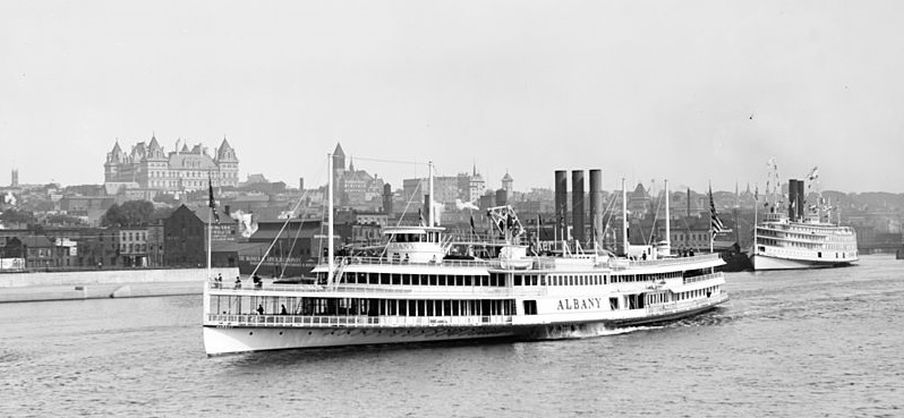
Above
: By 1880, day steamers were increasing in size and taking on a more
modern appearance. Albany is seen leaving New York City in 1884 when
just four years old. In the background is one of the "Night" boats with
stateroom accommodation. The three funnels located athwartships was a
more traditional arrangement indicating three boilers lying side by
side.
New York (1887-1908)
130373 KDTH
Built in 1887 at Wilmington DE
Steel 301
(335 after 1897) x 40.4 ft.. 1552 GT (1974 after 1897).
Beam engine by Fletcher of Hoboken 75 x 144 in, unusually placed
forward of the crankshaft.
Her paddle wheels were feathering, but she had traditional large round paddleboxes
Severely damaged in a collision in New
York in October 1908. Sank after fire broke out
overnight at the Newburgh repair yard and the ship sunk with four dead
from her crew of 74
Engine salvaged an used in the new-build Robert Fulton

Mary Powell (1902-1917)
016982
Built in 1861 by Allison Shipyard, Jersey City NJ.
Wood 288 x 34 ft 983 GT
Operated from Rondout to New York
Bought from Captain AE Anderson.
Mary Powell had an excellent reputation for speed and reliability and was often referred to as "Queen of the Hudson"
In Day Line ownership, the promenade deck was extended to the bow
She operated under the "Mary Powell Steamboat Company" brand
Withdrawn and laid up after the 1917 season and scrapped in 1919

Above
: Mary Powell. As well as the enormous paddle wheels, she had what was
a common funnel arrangement for her day, having been built in 1861.
Stacks abreast on the sponsons behind the wheels. This was because it
was usual for the boilers to be located here rather than in the hull of
the ship itself. This was possibly for stability reasons but more
probably as a safety measure. In early years, boilers were prone to
explosions, so this location would ensure that, on such occasion, the
damage to the ship would be minimised
Hendrick Hudson (1906-1948)
203424
Built by TS Marvel at Newburgh NY.
Steel 379.1 x 45.1 ft 2847 GT. Compound diagonal engine, 45 and 70 in x 84 in.
Withdrawn from service in 1948 but held in reserve by the Day Line's new owners. Scrapped in Philadelphia in 1951
http://www.newburghhistoricalsociety.com/history/proudly-launching-a-newburgh-giant/

Above
: Hendrick Hudson brought a new dimension to Hudson River services when
introduced in 1906 and was the first of four major paddle steamers
built for the "Day Line" as traffic built up to what became a peak in
1925. She considerably exceeded the century's first major modern
passenger steamer, Tashmoo, which sailed out of Detroit on the Great
Lakes.
Robert Fulton (1909-1954)
206288
Built
at Camden NJ.
Steel 337 x 42 ft 2168 GT. Walking beam engine ex-New York 75
x 144 in (which was the last Fletcher beam engine to operate a vessel).
Use
of New York's engine allowed the new ship to be ready quickly to
celebrate the centenary of Robert Fulton and the start of steamship
operations worldwide.
Withdrawn at the end of the 1954 season. In 1956 she was
towed to Jacksonville Florida and rebuilt with the intention of becoming a luxury floating
residential complex in the Bahamas
Her
actual use was as accommodation by a lumber company at Snake Cay,
Bahamas. When local logging operations ceased in 1967, she was
dismantled

Above : Rather surprisingly, the Day Line's next vessel, the Robert Fulton in
1909, had a beam engine, just as White Star Line's next tonnage after
Tashmoo. In a remarkable coincidence with White Star, their next vessel
also used a second-hand beam engine and the otherwise modern ship was
characterised by the swinging machinery poking through the upper deck.
They could be excused perhaps because the engine was salvaged from thir
sunken PS New York and was only twenty years old.
Washington Irving (1913-1926)
211170
Built at Camden NJ
Steel 400.5 x 47 ft 3104 GT
Licenced for 6000 passengers - the largest of any passenger vessel at the time
Her three funnels were arranged traditionally, but the forward stack was a dummy. Unusually, she had a cruiser stern.
Sank following a collision shortly after leaving her pier in New York City on 1st June 1926, with loss of 3 lives
https://en.wikipedia.org/wiki/PS_Washington_Irving

Alexander Hamilton (1924-71)
223775
Built by Bethlehem at Sparrow's Point.
Steel 338.6 x 77 ft 2367 GT Triple Expansion engine. First oil fired vessel in the fleet.
https://en.wikipedia.org/wiki/PS_Alexander_Hamilton

Above : The last classic paddle steamer Alexander Hamilton at the pier for the popular Bear Mountain outing
Courtesy : Hudson River Maritime Museum http://www.hrmm.org/
Smith Brothers of Nyack / Captains Woolsey & Nelson
Smith Brothers owned and operated her on a service to New York City out of Nyack, an approximate 25 mile run.
Chrystenah (1866-1911)
004879 HDSB
Built
in 1866 by Wm Dickey at Nyack
Wood 196.6 x 30.2 ft. 571 GT. Original
engine 46 x 120 in ex-Arrow, ex-Broadway dating from 1837. Rebuilt to
50 x 132 in
Smith Brothers owned and operated her on a service to New York City out of Nyack, an approximate 25 mile run.
Sold to captains Woolsey and Nelson in
1907 for excursion and charter work out of Newburgh
and in 1911 made runs down to the beaches and fun fairs at Coney
Island.
In 1912 she was moved down to Keansburg NJ for local services to New York City for one season
Remained in the New York area
Sold in 1920 for a planned service to Oyster Bay, Long Island, but laid up at New Rochelle and subsequently damaged in a storm.
Sold
off by the local city authorities, she was takenunder tow to Oyster Bay
but rather than being used, was scrapped and the hull run aground
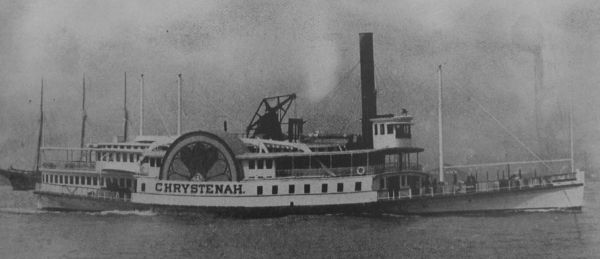
.
New Jersey Steamboat Co (People's Line) : Citizens Line Steamboat Co
Jointly known as the Hudson River Night Line
Merged to form the Hudson Navigation Company (1902-1935)
Vessels taken over by the Trojan Steamship Corporation (1936-1937)
The
Hudson Navigation Company was established by businessman C W Morse (1856-1933) though the
takeover of
the New Jersey Steamboat Company, which traded as the People's Line
between New York and Albany and
the Troy-based Citizens Line, which had been in operation since 1872.
The two identities remained separate within the new organisation
The
People's Line had been established by prominent steamship owner Daniel
Drew who had built up a strong presence on the river since 1831
which was strengthened further in 1845 with the takeover of the North
River Steamboat Association. The Association had started as a genuine
organisation for cooperation between individual owners but in later
years had become, by fair means or foul, the domain of a certain
Cornelius Vanderbilt who was
to become one of the richest men in the world when he moved on from his
roots in the New York steamship trade to become the US' main railway
magnate.
Morse
aquired numerous other steamship lines in the eastern USA as part of a
business empire which included banking. A share price manipulation
scandal in 1907 led to Morse's conviction in court and receivership for
many of his companies. Escaping a long jauil sentence, he retained
control of the Hudson Navigation
Company as
he rebuilt his empire, but the company went bankrupt in 1921 amid
further scandal and court appearances. Reconstituted as the Hudson
River Navigation Corporation, the business continued, but
the giant steamer CW Morse was symbolically renamed Fort Orange and
only lasted in service until 1927. The
three other large paddlers built after the CW Morse continued in
operation on the Night Line until 1937, latterly under the ownership of
New York businessman Samuel Rosoff's Trojan Steamship Corporation. Rosoff had made his fortune in construction projects building the city's subway
Paddle Steamers operating in the twentieth century :
Dean Richmond (1865-1909)
006264
Wood 348 x 46 ft 2525 GT
Built at new York NY Engine ex- Francis Skiddy of 1852.
Sank after a collision with
C.Vanderbilt on 20 Sept 1867 at Rhinecliff. Raised.
Engine connecting
rod broke on 14 June 1877 causing major damage.
Laid up and in reserve
from 1904. Reactivated after the loss of City of Troy in 1907. Scrapped
at Boston in 1909.

Above
: Dean Richmond exhibits the typical characteristics of a Night Line
steamer from the mid-19th century, including large paddle wheels and
funnel position dictated by the location of the boilers. Whilst her
contemporary, Drew, was withdrawn as the new company was established,
Dean Richmond had a short and unexpected swansong.
Drew (1866-1902)
Built by John Englis, New York.
390 x 47 ft. Beam engine by Valaire, 81 x 168 in. Boilers, which were new in 1885, salvaged ex- St John)
Destroyed by fire on July 4th 1902 while in the charge of scrappers at Perth Amboy
City of Troy (1876-1907)
125522
Built at Brooklyn NY
Wood 280 x 38 ft 1527 GT
Citizens' Line. Lost to fire 5 April 1907 at Dobbs Ferry
Saratoga (1877-1906)
115539
Built in 1877 at Brooklyn NY
Wood 282 x 36 ft 1438 GT
Sunk in 1906 in a collision with Adirondack but raised and repaired
Later sailed for a short time in opposition to the Night Line with the New York & Albany Transportation Company
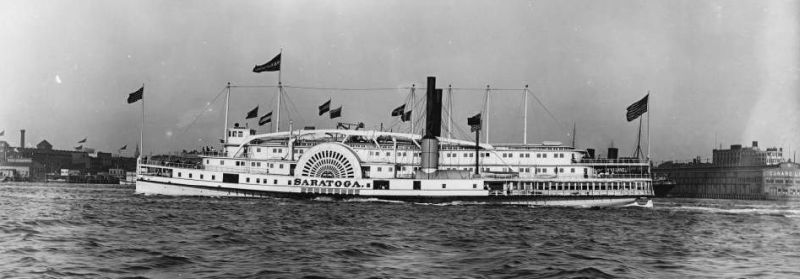
Adirondack (1896-1917)
107230
Built by John Englis, Brooklyn NY
Wood 386.2 x 50 ft. 3644 GT Beam engine by Fletcher of Hoboken 81 x 144 in
People's Line
Damaged in a collision near Tivoli in 1906 in which the steamship Saratoga sank with one life lost on each vessel
Used by the army as a floating barracks from 1917 to 1919
Laid up at Athens after war service and sank through ice pressure on December 29th 1925. Scrapped shortly afterwards
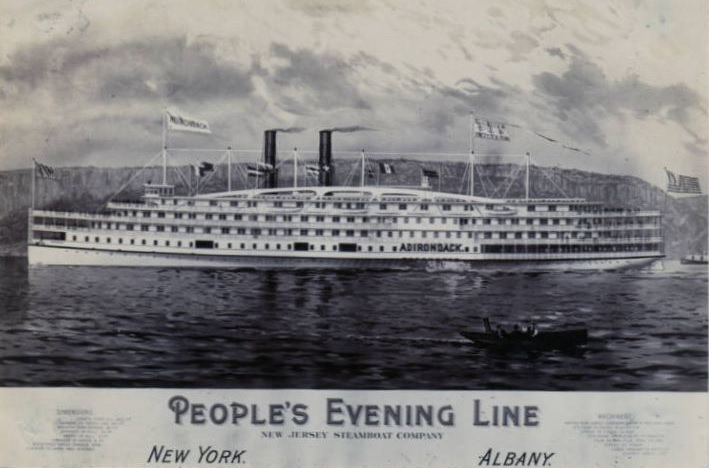
Above
: A print of Adirondack, a popular way of advertising a new vessel
throughout the 19th century. The enormous size of vessels such as this
put great stresses on the wooden hulls. Tensioning beams (hog trusses) had to
be used to strengthen the structure as can be seen arching over
the superstructure
Onteora (1898-1917)
155322
Built in 1898 at Newburgh NY
Steel 236.7 x 35.2 ft 1213 GT Beam engine
Sold to McAllister Navigation Company of New York and became an excursion ship on the Hudson.
Destroyed by fire at Bear Mountain in 1936
New build in the 20th Century :
C.W. Morse (1904-1921)
200894
Built in 1904 by Harlan & Hollingsworthh at Wilmington
Steel 411.1 x 50.8 ft. 4307 GT. Beam engine 81 x 144 in by Fletcher of Hoboken NJ
Peopl's Line
Renamed
Fort Orange by the receivers of Morse's collapsed business empire in
1921.
Continued in service until 1927. Laid-up until scrapped in 1935.
The hull was taken to Bridgeport as a harbour breakwater
https://en.wikipedia.org/wiki/USS_C._W._Morse_(ID-1966)
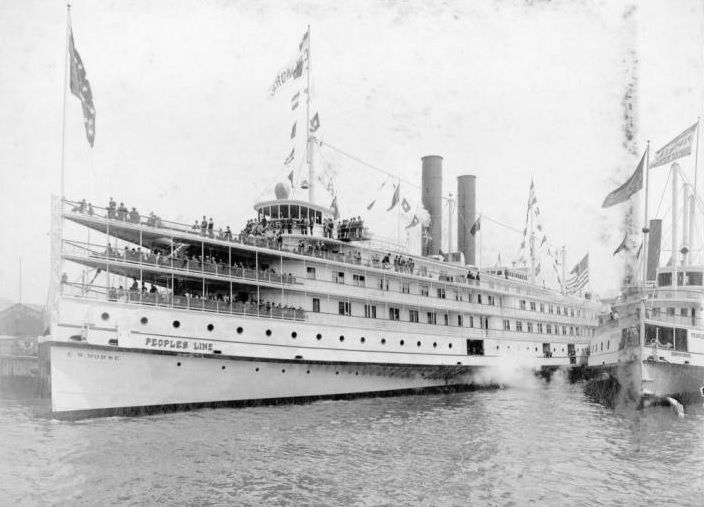
Above
: CW Morse, aptly named after the tycoon who had acquired control over
the "Night Lines" was the first addition to the palatial steamer fleet
in the 20th century. At 430 feet long And 4307 GRT she was a giant and a match for her new-build contemporaries on Lake Erie.
Greenport (1910-1912)
022152 HQNM
Built in 1866 at New York NY
Wood 244.2 x 35.2 ft 1413 GT
1870-1901 Kennebec Steamboat Company on the Maine coastal service as Star of the East and later Sagahadoc
1902-1906 Montauk Steamship Company on Long Island Sound as Greenport
1907-9 Richard Halley at Newark NJ
1910 Hudson Navigation Company
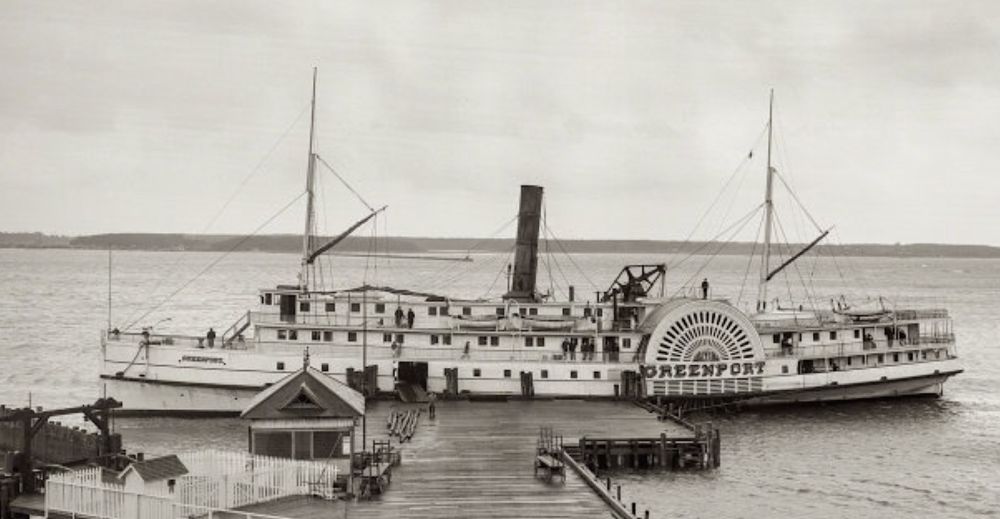
Frank Jones (1914-1915)
120903 KLHQ
Built in 1892 at Bath ME
Wood 253.2 x 36.3 ft 1634 GT
Served on Maine coastal services for the Boston & Maine
Railroad and later the Maine Central Railroad and Portland, Mount
Desert & Machiasport Steamboat Co out of Portland.
Bought by the newly-formed Enterprise Line in 1905 to link New York City with Fall River and Providence
In 1908 the ship was bought out of receivership to sail on the Hudson River.
1908-1909 New York & Albany Transportation Company (the New Hudson Line)
1910 Manhattan Navigation Company
1911-1913 New York, Albany & Troy Transportation Line
1914-1915 Hudson Navigation Company
After the 1915 season she was laid up and renamed Fenmore
Requisitioned
by the US Army in 1918 but on 22nd of June that year she caught fire
whilst carrying ammunition and exploded on the York River, Virginia
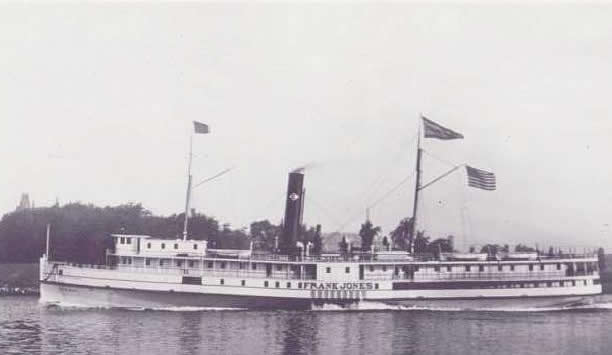
Trojan (1909-1935)
206129
Built in 1909 by TS Marvel at Newburgh NY
Steel 317.2 x 42.5 ft. 2571 GT. Beam engine by Fletcher, Hoboken 72 x 144 in
Citizens Line
Sold after the 1935 season to Mr S Rosoff who operated her in 1936 and 1937 and she was laid up at Marlboro
Reactivated
in 1939 and renamed New Yorker to carry crowds for the Worlds Fair
Compant to the Fair grounds and laid up once more.
Destroyed by fire on March 1st, 1940
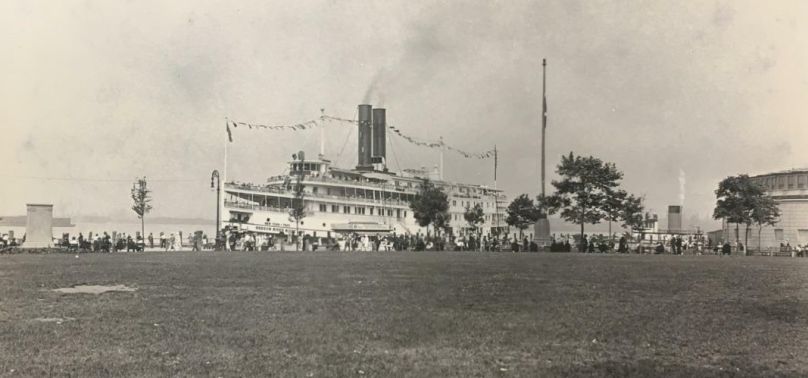
Rensselaer (1909-1935)
206501
Built in 1909 by TS Marvel at Newburgh NY
Steel 317.3 x 42.5 ft. 2690 GT Beam engine by Fletcher, Hoboken 72 x 144 in
Entered service in July 1909 on Citizens Line to Troy
Sold after the 1935 season to Mr S Rosoff who operated her in 1936 and 1937 and she was laid up at Marlboro
Bought
by the US Government and towed to Providence RI. Found unsuitable for
the US Government and with no buyers, she was sold for scrap and
demolished in 1943
Berkshire (1913-1935)
211149
Built in 1913 at Hoboken NJ
Steel 422.4 x 50.6 ft 4300 GT
People's Line
Sold after the 1935 season to Mr S Rosoff who operated her in 1936 and 1937 and she was laid up at Marlboro
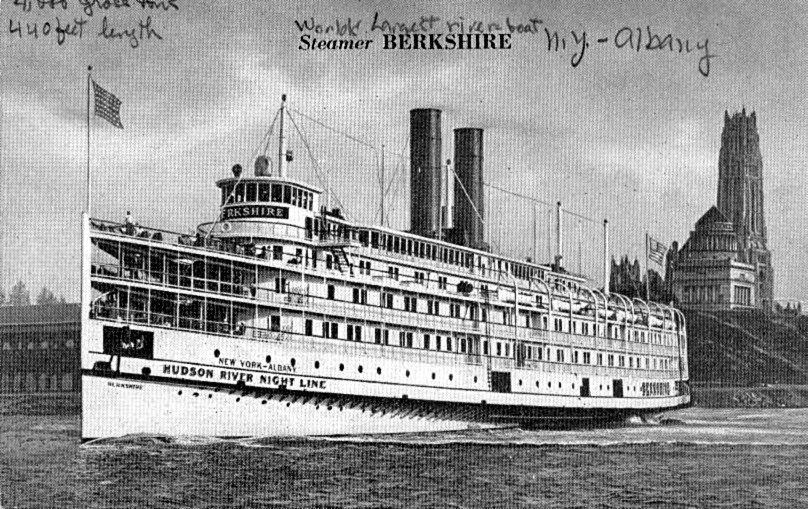
.
New York & Albany Transportation Company (the New Hudson Line)
Operated a short-lived service on the Hudson in 1908 and 1909 using old tonnage from the main Night Line operation
Saratoga (1908-1909)
115539
Built in 1877 at Brooklyn NY
Wood 282 x 36 ft 1438 GT

Frank Jones (1908-09)
120903 KLHQ
Built in 1892 at Bath ME
Wood 253.2 x 36.3 ft 1634 GT
Served on Maine coastal services for the Boston & Maine
Railroad and later the Maine Central Railroad and Portland, Mount
Desert & Machiasport Steamboat Co out of Portland.
Bought by the newly-formed Enterprise Line in 1905 to link New York City with Fall River and Providence
In 1908 the ship was bought out of receivership to sail on the Hudson River.
1908-1909 New York & Albany Transportation Company (the New Hudson Line)
1910 Manhattan Navigation Company
1911-1913 New York, Albany & Troy Transportation Line
1914-1915 Hudson Navigation Company
After the 1915 season she was laid up and renamed Fenmore
Requisitioned
by the US Army in 1918 but on 22nd of June that year she caught fire
whilst carrying ammunition and exploded on the York River, Virginia

.
Central Hudson Steamboat Company (1899-1929)
The
Central Hudson Steamboat Co was a new name on the River Hudson at the
turn of the century. In 1899 the long-time owners of a leading paddle
steamer operator Romer
& Tremper whose joint business came to dominate services based on
the central part of the Hudson sold their business. It was based at Newburgh where the firm was
registered and sailed out of Rondout Creek at Kingston, with overnight
services to Albany as well as a substantial cargo transportation
business. William F Romer had started out in the steamship
business in 1848 in partnership with Captain Anderson who became owner
of the famous Mary Powell. Captain Tremper had started in the 1830s
with Fanny and later acquired Emerald and North America, sailing out of Roundout Creek
The
company filed for bankruptcy in 1929. Jacob H Tremper, their only
remaining paddle steamer was scrapped. Two screw steamers (Newburgh and
Homer T Ramsdell) went to Nantasket as they tried to rebuild their
fleet after a devastating fire. Steel steamer Benjamin B Odell, dating
only from 1911. saw further service at New York for the Hudson River
Steamboat Company and in 1935 and 1936 on the Hudson for Samuel
Rosoff's failed Hudson enterprise. She burned out in lay-up in February
1937.
Paddle Steamers operating in the twentieth century : Aquisition dates are as for the original Romer and Tremper company
James W Baldwin (1861-1911, from 1903 as Central-Hudson)
013190
Built
in 1861 by Allison of Jersey City.
Wood Lengthened to 273.5 x 34
ft 1002 GT Beam engine by Fletcher, Harrison 60 x 132 in
Built for Captain Tremper as James W Baldwin
Rebuilt and reboilered in 1903 and renamed Central-Hudson
Displaced
in 1911 by the new Benjamin B Odell and then chartered to the Manhattan
line for a New York - Albany service but had two quick grounding
incidents
Sold for scrap in late 1911

Above : As James W Baldwin - Below : As Central-Hudson
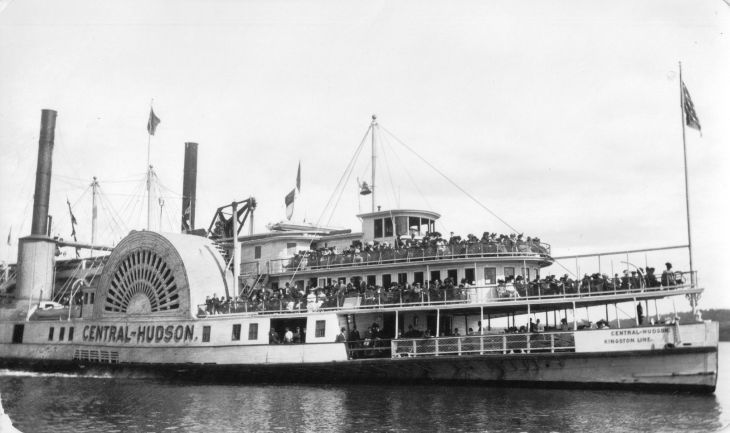
M Martin (1863-1919)
090072
Built in 1863 at Jersey City NJ
Wood 191 x 29.3 ft 570 GT Engines by Fletcher & Harrison 44 x 108 in
Served as general Grant's dispatch boat on Chesapeake Bay during the Civil War and hosted President Lincoln
Post war she ran between Bangor ME and Portland ME
Joined the Romer & Tremper fleet and ran between Newburgh and Albany on the Hudson River
Sold for scrapping in 1920
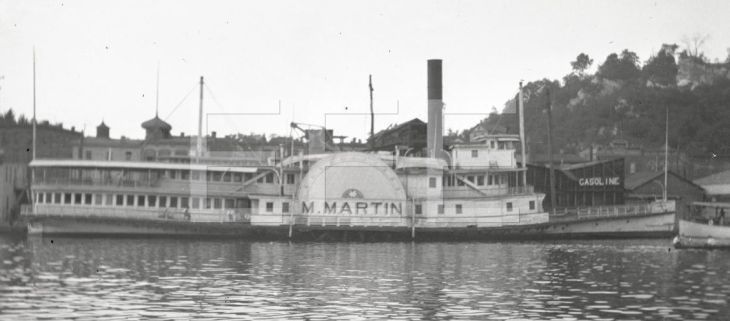
Jacob H Tremper (1885-1929)
076574
Built in 1885 by Herbert Lawrence at Greenpoint NY.
Wood 180 x 30 ft 571 GT Engine by W
Fletcher of Hoboken
Beached 21 July 1913 at Staatsburg after hitting rocks. Raised and returned to service in 1916.
Laid up in 1929 and scrapped at Newburgh in 1929.
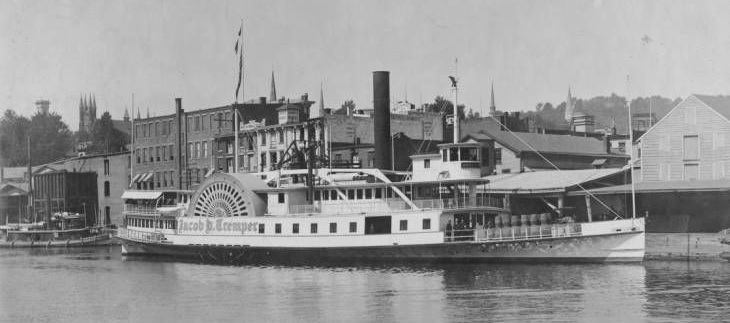
William F Romer (1890-1916)
091372
Built in 1881 at Baltimore MD
Wood 221.7 x 59.2 ft 880 GT
Originally Mason L Weems of the Weems Line, used on Chesapeake Bay services.
Sold in 1920 but abandoned at Eavesport
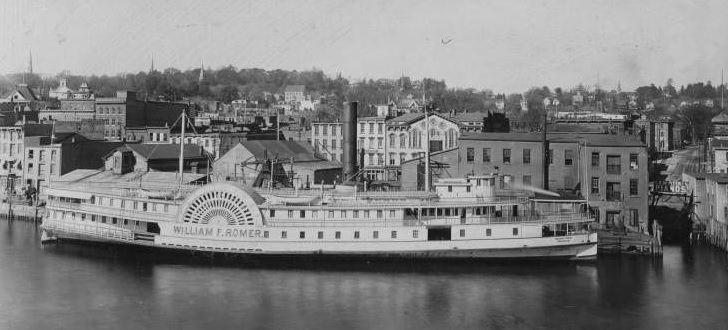
Other Passenger Paddle Steamers in the 20th Century
Numerous
small shipping companies operated services from their towns
particularly to link them with New York City, ferrying supplies and
cargoes in either direction as well as passengers for whom
accommodation was provided on night-time services. A number retained
their river paddle steamers. There remained other paddle steamers, particularly smaller tug boats
New York, Catskill and Athens Steamboat Company - Catskill New York Evening Line
The
company was established in 1863. It continued as a freight transport
company, but without paddle steamers after Clermont was sold in 1919 when the business went into liquidation
Kaaterskill (1882-1914)
014408
Built in 1882 in Athens NY
Wood 270 x 38 ft. 1361 GT Beam engine by Fletcher & Harrison 63 x 144 in.
Dismantled at Newburgh in 1914
City of Hudson, ex-Catskill, (1883-1910)
007972
Built in 1863 at Mysto Bridge CT
Wood 226.2 x 28.6 ft 675 GT
Operated by the Catskill New York Evening Line
Built at Mystic Bridge CT in 1863 for Connecticut River and Long Island Sound as Escort
1883 Purchased by the Catskill New York Evening Line. Rebuilt and re-named Catskill
1879 sunk in collision in New York with loss of one child's life
Rebuilt and lengthened to 226.2 ft and 816 GT 624 NT. Renamed City of Hudson
Withdrawn at the end of the 1910 season and scrapped shortly afterwards
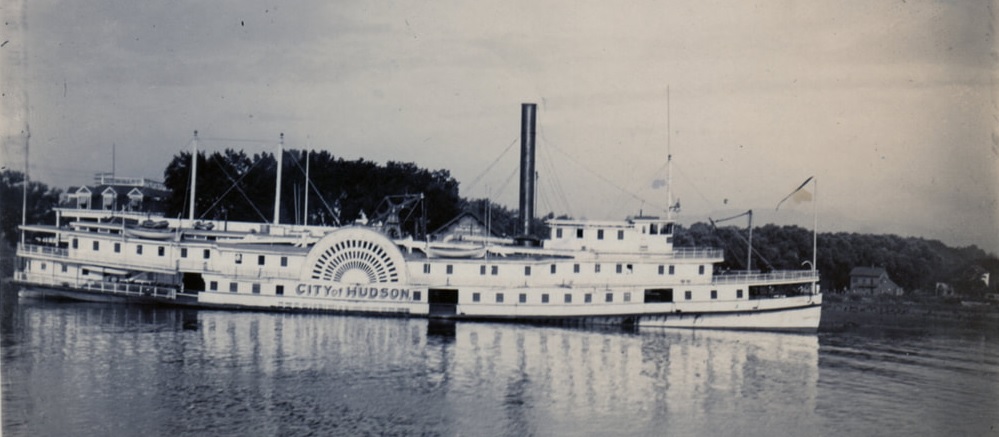
Clermont (1911-1918)
Built in 1911 at Newburgh NY
Iron 271.5 x 39.2 ft 1864 GT Beam engine
Sold
in 1919 to the Commissioners of Palisades Park after the liquidation of
the company
Converted into a day steamer
Owned by the McAllister Navigation Company of New York and ran excursions to Bear Mountain
Saugerties and New York Steamboat Company (1889) : Saugerties and New York Evening Line
Established
in 1889 to compete with the New York and Saugerties Transportation
Company which had established in 1865 and operated the Ansonia. The new
company purchased the Shenandoah of 1882 and renamed her
Saugerties. Two years later they bought out the older company and its
paddle steamer Ansonia, rebuilding her and re-naming her Ulster.
Saugerties (1889-1903)
115843
Built in 1882 at Brooklyn NY
200 x 33 ft. 848 GT
Ex- Shenadoah
Burnt out through a fire when berthed at her wharf. She was raised and the remains beached
Ulster (1892-1931, as Robert A Snyder from 1921)
025290
Built in 1892 at Brooklyn NY
205 x 30.5 ft 780 GT
Although now classed as a new vessel, she was a rebuild of Ansonia, originally built in 1848 an on the Hudson since 1860
Rebuilt and reappeared for the 1921 season as Robert A Snyder
Laid up after the 1931 season and destroyed by ice in winter of 1935/6
Ida (1904-1931)
100281
Built in 1881 at Wilmington DE
Iron 190 x 54.6 ft 765 GT
Built for service on Chesapeake Bay by the Baltimore, Chesapeake & Atlantic Railway
Rebuilt after extensive fire damage in 1894
Bought in 1904 to replace Saugerties
Withdrawn in 1931 and scrapped in 1937
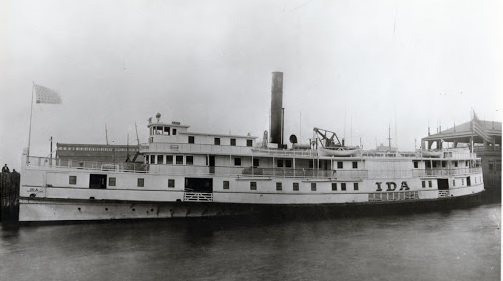
New York, Albany & Western Steamship Company
Lancaster (1924-1928)
141217
Built in 1892 at Sparrow's Point MD
Steel 205.4 x 50.1 ft 919 GT
Built for the Weems Line for Chesapeake Bay Service
The Weems Line became part of the Delaware, Maryland & Virginia Railroad in 1904
Sold to the New York, Albany & Western Steamship Company. Abandoned 1928
Paddle Towboat Norwich
Operating
out of Albany as a towboat until 1923, the former passenger ship was
billed as the oldest steamboat in the world when it took part in the
centenary celebrations of the world's first commercial steamboat in
1909. Norwich was built to link Norwich CT and New York City
Norwich (1836-1923)
018578
Built in 1836 at New York NY
Wood 160 x 25 ft 255 GT Cross-head engine 40 x 228 in
Built for the New York City to Norwich CT service
Briefly served on Chesapeake Bay
Came to the Hudson River in 1843, running between Rondout and New York until 1848
Converted to a tow boat and gained a reputation as a fine ice breaker
Sank in Rondout Creek in the winter of 1906 but raised and repaired
Sank in lay-up at Port Ewen in 1923 and scrapped

Go to
Great Lakes (USA)
Hudson River
New York City, Coney Island and Northern New Jersey Coast
Long Island Sound and North Eastern Seaboard
Delaware River
Chesapeake Bay
South East Coast and Gulf of Mexico
Lakes Champlain, George, Cayuga and Winnepesaukee
Mississippi River System
Lake Coeur d'Alene
Pacific seaboard (USA)
Canada
Return to
USA & Canada
Historical Database


























